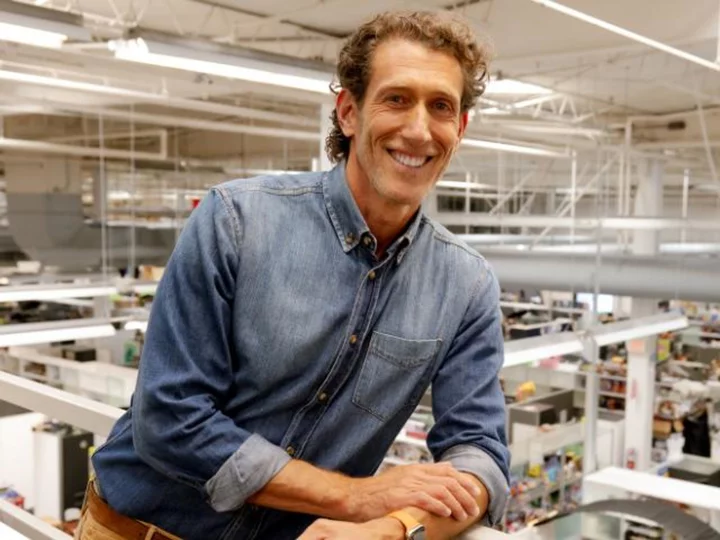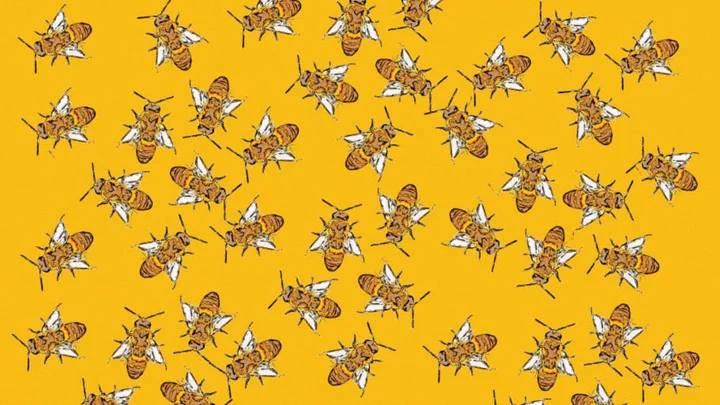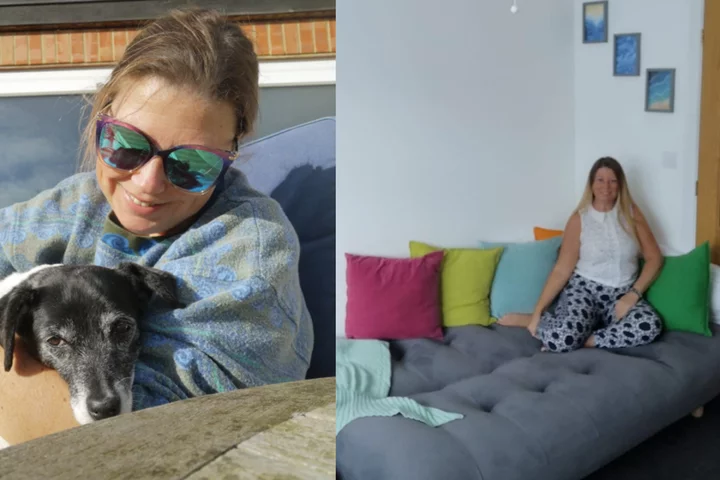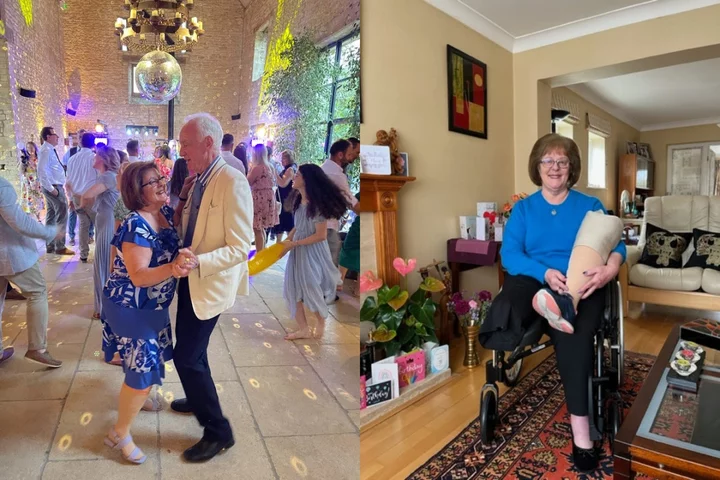
Billionaire Brothers, JPMorgan Refinance NYC Luxury Condo Tower
Billionaires David and Simon Reuben have bolstered their New York City property investments, helping to refinance debt on
2023-07-27 01:22

Matt Moulding’s THG Agrees to Buy London Newspaper City AM
THG Plc, the online health, beauty and wellness retailer, has agreed to buy UK business newspaper City AM.
2023-07-27 00:59

Gasoline Is Surging All Over the World in Fresh Inflation Blow
The price of gasoline is starting to surge everywhere, an inflationary omen for central banks and governments the
2023-07-27 00:27

Gap hires Mattel president to be its new CEO
The retailer announced Wednesday that Richard Dickson, currently Mattel's president and chief operating officer, will assume the position. He's been with the toymaker for a collective 20 years, most recently from 2014 until now, where he helped revitalize the Barbie brand.
2023-07-26 23:51

Meet the professional cuddler charging £70-an-hour to hug ‘the big spoons in life’
A professional cuddler who makes a living giving clients hugs has said people travel from all over the globe to receive the cuddle therapy she offers which is “far less intimate than a massage” and helps people from “all walks of life”. Natasha Wicks, 44, from Coventry, West Midlands, says that despite criticism, cuddling is scientifically proven to release happy hormones like dopamine and that a lot of her clients are “the big spoon in life” and go to her for emotional support that they do not have at home. As such, many of her clients are caregivers and most of them join Natasha for two-hour hugging sessions, costing £70 an hour. The sessions vary depending on what the client wants, some having “emotional hugs”, others talking more and some wanting to “sit at opposite ends of the sofa with our legs and feet entwined”. Natasha became a cuddle therapist in 2015 and, while she has had comments online from people criticising the practice, she said that her family and friends were unsurprised when she first started giving professional cuddles. She said: “They all said to me that I give the best cuddles so it’s not surprising that I’d start doing it as a job. “It’s very much what I do, I help people and want to make people feel better. It’s a natural thing when someone is going through a tough time to want to give them a hug. “Cuddle therapy might not be as widely accepted in society but it’s far less intimate than other things like massages which are seen as normal.” Prior to becoming a cuddler, Natasha originally trained as a CBT therapist and counsellor. She said: “There’d be situations where I would be talking to someone and they’d really need a hug, but obviously, you’d have professional boundaries in place and it wouldn’t have been appropriate. “It was just a really natural thing. One client had finished her final session and we had agreed that she wasn’t my patient anymore so we hugged goodbye. She said to me that she’d wanted to do that for a long time and I thought ‘me too’.” Looking into cuddle therapy, which she said was increasing in popularity in 2014, Natasha took a training course. By 2015, she was a qualified cuddler and started taking on new patients for cuddle sessions. Natasha provides a minimum session of one hour but said most people go for at least two hours, sometimes longer if they are receiving more than one type of therapy. She said: “I always give people a hug on the doorstep when they arrive and then they’ll come in and relax, and we’ll have an initial chat about what brings them here. After that, I’ll put on some ambient music and we’ll have a cuddle on my cuddle sofa. “It can be daunting coming into a stranger’s house and I can tell the difference in them from arriving to leaving. The first hug they might be angled away from me but when we’re hugging goodbye, I can get my head in between their neck and shoulders and you can almost feel that a weight has been lifted from them.” There is not one type of person that visits Natasha for cuddles, but she says that a lot of her clients are caregivers. She said: “There’s all sorts of people who come for a cuddle, from people who have moved away from home for the first time and just want a mum hug all the way to people in their 80s. “I’m inclusive of all genders and all ages. I get a lot of clients who are the carers of their family and they are so busy looking after other people, and probably giving the hugs and support to other people, that they don’t have that for themselves. “A lot of people that come to see me are generally people are the big spoon in the life – they take care of others and don’t want to show a vulnerable side to people because they don’t want people to worry that they can’t cope. “I get a lot of carers, a lot of NHS staff, a lot of mums, a lot of people that are in a world where they have to be the strong one in the situation and they just want to be able to come here and let their guard down.” Natasha’s priority is to make people feel at ease when they arrive as she said it can be “nerve wracking” turning up at someone’s house for a hug. Setting out clear boundaries prior to meeting, the therapist has said that the patients she has welcomed into her home have all been respectful. She added: “I always say to people that when your body relaxes, your tummy might crumble and mine might too, but that people don’t need to worry about it. Sometimes people fall asleep and they might snore or fart, it’s just natural things that happen. It’s happened twice where someone has got an erection and that’s fine, I have boundaries and we’ll just change position. “I want people to feel reassured that, as soon as they get in, they feel comfortable.” Despite the unconventional therapy, when Natasha first took on cuddle clients, she said her family were completely “unsurprised” and the step from CBT therapy to cuddle therapy was a “natural evolution”. While Natasha focuses her time on a holistic approach for treating people, she noted that there is also neuroscience behind cuddles. According to the 44-year-old, physical touch activates the brain’s orbitofrontal cortex and cuddling releases oxytocin, dopamine and serotonin. Now, Natasha also does EMDR therapy and is a mental health swim host, and has clients travel from all over the globe to receive her hugs. She said: “Working from Coventry is brilliant because I’m only nine minutes on the train from Birmingham Airport and people come to visit me from all over. I get a client from Belgium, someone from Ireland and people from all over the UK who come to see me. “I wanted to find a sofa bed that just looked like a big comfy sofa for cuddle sessions. I’d started off with a big L shaped sofa but after about five years, it was sagging a bit, there’d been a lot of healing done on that sofa and it was time for a new one. “Now I have a sofa bed in my living room that I use as my cuddle sofa. It’s in the living room and it’s used for everyday life, watching TV with my partner, having people round and also for my work.” Breaking down the taboo around cuddle therapy, Natasha hopes more people will embrace the alternative treatment. She added: “As it’s become more popular, more people are becoming qualified as cuddlers and I think that’s great. “I’ve had comments online before of people thinking it’s weird or not understanding but there are other things we accept in society that are much more intimate than cuddles, like massages. “It’s not weird, it’s actually a really lovely thing to be able to make another soul feel better for a while.” Read More Charity boss speaks out over ‘traumatic’ encounter with royal aide Ukraine war’s heaviest fight rages in east - follow live New warnings about ‘concerning’ rise in at-home cosmetic dentistry What is ‘beer tanning’ and why are experts warning against it? Christian Cowan: Designing is like dreaming
2023-07-26 22:57

The Origins of the Phrase ‘Bee in Your Bonnet’
We’re all familiar with the feeling of having an idea or subject stuck in your head that makes it difficult to think about anything else. But why (and when) did we start comparing that experience to a bee buzzing around in your hat?
2023-07-26 22:17

Just Eat CEO Says Grubhub Sale Is Proving ‘Very Difficult’
Just Eat Takeaway.com NV is finding it difficult to complete the sale of its US business, Grubhub Holdings
2023-07-26 21:59

Etihad Bets on Premium Leisure With Return of ‘Apartments’ in Sky
Etihad Airways brought back its Airbus SE A380 superjumbos after three years in a bid to attract premium
2023-07-26 21:56

Meet the former therapist making a living as a professional cuddler
A professional cuddler who makes a living giving clients hugs has said people travel from all over the globe to receive the cuddle therapy she offers which is “far less intimate than a massage” and helps people from “all walks of life”. Natasha Wicks, 44, from Coventry, West Midlands, says that despite criticism, cuddling is scientifically proven to release happy hormones like dopamine and that a lot of her clients are “the big spoon in life” and go to her for emotional support that they do not have at home. As such, many of her clients are caregivers and most of them join Natasha for two-hour hugging sessions, costing £70 an hour. The sessions vary depending on what the client wants, some having “emotional hugs”, others talking more and some wanting to “sit at opposite ends of the sofa with our legs and feet entwined”. Natasha became a cuddle therapist in 2015 and, while she has had comments online from people criticising the practice, she said that her family and friends were unsurprised when she first started giving professional cuddles. She said: “They all said to me that I give the best cuddles so it’s not surprising that I’d start doing it as a job. “It’s very much what I do, I help people and want to make people feel better. It’s a natural thing when someone is going through a tough time to want to give them a hug. “Cuddle therapy might not be as widely accepted in society but it’s far less intimate than other things like massages which are seen as normal.” Prior to becoming a cuddler, Natasha originally trained as a CBT therapist and counsellor. She said: “There’d be situations where I would be talking to someone and they’d really need a hug, but obviously, you’d have professional boundaries in place and it wouldn’t have been appropriate. “It was just a really natural thing. One client had finished her final session and we had agreed that she wasn’t my patient anymore so we hugged goodbye. She said to me that she’d wanted to do that for a long time and I thought ‘me too’.” Looking into cuddle therapy, which she said was increasing in popularity in 2014, Natasha took a training course. By 2015, she was a qualified cuddler and started taking on new patients for cuddle sessions. Natasha provides a minimum session of one hour but said most people go for at least two hours, sometimes longer if they are receiving more than one type of therapy. She said: “I always give people a hug on the doorstep when they arrive and then they’ll come in and relax, and we’ll have an initial chat about what brings them here. After that, I’ll put on some ambient music and we’ll have a cuddle on my cuddle sofa. “It can be daunting coming into a stranger’s house and I can tell the difference in them from arriving to leaving. The first hug they might be angled away from me but when we’re hugging goodbye, I can get my head in between their neck and shoulders and you can almost feel that a weight has been lifted from them.” There is not one type of person that visits Natasha for cuddles, but she says that a lot of her clients are caregivers. She said: “There’s all sorts of people who come for a cuddle, from people who have moved away from home for the first time and just want a mum hug all the way to people in their 80s. “I’m inclusive of all genders and all ages. I get a lot of clients who are the carers of their family and they are so busy looking after other people, and probably giving the hugs and support to other people, that they don’t have that for themselves. “A lot of people that come to see me are generally people are the big spoon in the life – they take care of others and don’t want to show a vulnerable side to people because they don’t want people to worry that they can’t cope. “I get a lot of carers, a lot of NHS staff, a lot of mums, a lot of people that are in a world where they have to be the strong one in the situation and they just want to be able to come here and let their guard down.” Natasha’s priority is to make people feel at ease when they arrive as she said it can be “nerve wracking” turning up at someone’s house for a hug. Setting out clear boundaries prior to meeting, the therapist has said that the patients she has welcomed into her home have all been respectful. She added: “I always say to people that when your body relaxes, your tummy might crumble and mine might too, but that people don’t need to worry about it. Sometimes people fall asleep and they might snore or fart, it’s just natural things that happen. It’s happened twice where someone has got an erection and that’s fine, I have boundaries and we’ll just change position. “I want people to feel reassured that, as soon as they get in, they feel comfortable.” Despite the unconventional therapy, when Natasha first took on cuddle clients, she said her family were completely “unsurprised” and the step from CBT therapy to cuddle therapy was a “natural evolution”. While Natasha focuses her time on a holistic approach for treating people, she noted that there is also neuroscience behind cuddles. According to the 44-year-old, physical touch activates the brain’s orbitofrontal cortex and cuddling releases oxytocin, dopamine and serotonin. Now, Natasha also does EMDR therapy and is a mental health swim host, and has clients travel from all over the globe to receive her hugs. She said: “Working from Coventry is brilliant because I’m only nine minutes on the train from Birmingham Airport and people come to visit me from all over. I get a client from Belgium, someone from Ireland and people from all over the UK who come to see me. “I wanted to find a sofa bed that just looked like a big comfy sofa for cuddle sessions. I’d started off with a big L shaped sofa but after about five years, it was sagging a bit, there’d been a lot of healing done on that sofa and it was time for a new one. “Now I have a sofa bed in my living room that I use as my cuddle sofa. It’s in the living room and it’s used for everyday life, watching TV with my partner, having people round and also for my work.” Breaking down the taboo around cuddle therapy, Natasha hopes more people will embrace the alternative treatment. She added: “As it’s become more popular, more people are becoming qualified as cuddlers and I think that’s great. “I’ve had comments online before of people thinking it’s weird or not understanding but there are other things we accept in society that are much more intimate than cuddles, like massages. “It’s not weird, it’s actually a really lovely thing to be able to make another soul feel better for a while.” Read More Charity boss speaks out over ‘traumatic’ encounter with royal aide Ukraine war’s heaviest fight rages in east - follow live What is ‘beer tanning’ and why are experts warning against it? Christian Cowan: Designing is like dreaming Deborah James’s daughter launches anniversary clothing line for Bowelbabe Fund
2023-07-26 21:55

New warnings about ‘concerning’ rise in at-home cosmetic dentistry
There has been a 116% increase in DIY cosmetic dentistry over the past five years, new research has found, with social media driving up demand. Bupa Dental Care found that 20% of people who have attempted at-home treatments on their teeth had done so with teeth whitening kits, 13% had used plaque scraping gadgets, and 11% had purchased braces online. The research, which surveyed over 2,000 consumers in the UK – nearly 20% of whom were found to have tried dentistry products at home – was done in collaboration with Censuswide, a global insight-driven research company. Shockingly, it also found that 16% of those people were influenced by hacks on TikTok and other social media sites to create their own teeth-whitening concoctions with hydrogen peroxide. The chemical can cause mouth infections or other wider health complications, if not used correctly, Bupa said. “DIY dental treatment can seem like a big cost saving initially,” Chris Hanford, a Bupa Dental Care dentist, said: “However, such treatment can cause irreversible damage that can not only lead to pain but end up being more complex and costly to fix. “The problem is that dental treatment at home is not professionally prescribed or supervised – and there’s the added risk of buying counterfeit whitening kits.” One respondent, who experienced negative side effects from DIY dentistry, said: “It doesn’t last and constantly costs more money on top of what has already been paid.” Dr Safa Al-Naher, director and principal dentist at Serene, said: “The marketing for online braces – clear and called aligners – is really good. It’s also a really attractive prospect to people who want a quick fix. This is the day and age of Amazon, it’s one click and you get it.” But the consequences of DIY dental treatments vary. The research found that 74% of people who’d done it needed emergency treatment to fix their issues. One in six people out of the group reported that they now have damaged tooth enamel, brittle teeth, tooth and gum sensitivity, weakened and brittle teeth bruising or damaged dental bone. “Any at-home teeth-whitening can cause damage to tooth enamel, give rise to tooth decay, as well as gum and tooth sensitivity – particularly if they’re used too frequently. Poorly planned or ill-fitting braces can cause anything from wobbly teeth or gum recession to damaged bone,” Hanford adds. It’s why Al-Naher is “very worried and concerned” about the rise in at-home cosmetic dentistry. “I have personally seen many cases that have come through to me, some disastrous. It is a false economy ultimately, as you spend your money on these products initially and then you spend more money again to get them fixed,” he said. “This discourages people from taking care of their teeth on a regular basis, visiting their dentists every six to 12 months.” Read More Charity boss speaks out over ‘traumatic’ encounter with royal aide Ukraine war’s heaviest fight rages in east - follow live What is ‘beer tanning’ and why are experts warning against it? Christian Cowan: Designing is like dreaming Deborah James’s daughter launches anniversary clothing line for Bowelbabe Fund
2023-07-26 21:48

Coca-Cola Raises Outlook as Consumers Head Back to Events
Coca-Cola Co. raised its full-year guidance after second-quarter results show continued momentum and consumer willingness to pay higher
2023-07-26 19:57

Grandmother with rare cancer that led to amputation shares first warning sign
A grandmother who was diagnosed with a rare cancerous tumour after her ankle “looked a bit swollen” had to have her leg amputated, but she is now walking with a prosthetic and has achieved her goal of waltzing again with her husband. Shirley Parnell, 75, a retired production coordinator, who lives in Kings Langley, Hertfordshire, with her husband, Lawrence, 76, a retired chartered surveyor, noticed a lump on her ankle in July 2022, and little did she know, it would lead to a devastating diagnosis. Shirley “assumed it would be something that (doctors) could fix”, but, after several scans, she was diagnosed with spindle cell sarcoma, a rare malignant cancerous tumour, and was told a leg amputation would be the only way forward. The mum of two and grandmother of two felt “shocked and in disbelief” as it “hadn’t even crossed (her) mind” that she was going to be diagnosed with cancer. After the surgery, Shirley had an “overwhelming sense of relief” and focused on getting better – to motivate herself, she set herself the goal of being able to dance with her husband again. But, while learning to walk again, Shirley was diagnosed with metastasis lung cancer and could not help but feel “a little bit cheated” as her parents lived until their 90s and she now knows “that’s probably not going to happen.” She did not let this get in the way of her achieving her goal, and in the middle June 2023, she danced with her husband again at a friend’s wedding and said she “had a real sense of achievement”. In July 2022, Shirley got her first warning sign of cancer when she experienced pain in her right ankle. Shirley told PA Real Life: “My ankle started to look a bit swollen – at first, I didn’t think anything of it as I assumed I had just knocked it on something in the house and not realised, but then I noticed a lump. “The lump kept moving around and the pain started to get more intense. So much so that I decided to go and see my local GP.” Shirley’s GP thought it could be a blood clot, so she was prescribed cream and tablets, but after a week, nothing improved. She was then referred to Watford General Hospital for a blood test and an X-ray. Shirley said: “I had just assumed it would be something that they could fix with some medication and the thought of something more serious didn’t really cross my mind. “It was only when they said that the X-ray had come back showing some abnormalities and they wanted me to have an MRI scan, a CT scan and a biopsy that I started to worry. “A few weeks went by, and I tried not to think about the results but then I got a call saying the results were back and they wanted to see me, and I just felt like it was going to be bad news.” At the appointment, Shirley was told she had spindle cell sarcoma, a rare malignant cancerous tumour which can develop in the bone or soft tissue. The doctor suggested that the only option for Shirley was to have her leg amputated to remove the tumour. She said: “As he said those words, I felt shocked and disbelief. “I thought at the time, only last week I was living my life normally, doing things I would come to take for granted such as walking to the shops or going to a Pilates class. “It hadn’t even crossed my mind that it might be cancer, let alone that I would lose a limb because of it.” So, on October 24 2022, at the Royal National Orthopaedic Hospital in Stanmore, Greater London, Shirley had the surgery. She said: “I was very nervous going into surgery but funnily enough I was okay once it was done. “I just had an overwhelming sense of relief that that part was finished. “Everyone has always said to me that I am a very determined person and after the surgery, I just started to look to the future as I felt everything was getting better, so I focused on working towards that.” But, once her leg was amputated, Shirley could not help but feel like she had lost some independence. She said: “Before I could just pop out to pick up some essentials but I had to rely on others to help me, something I am learning to get better at. “I’m so grateful for my husband running me around though.” On January 27 2023, Shirley had a cast made for her prosthetic leg, and it was fitted a week later. She said: “Then came the long and challenging journey of learning how to walk again. “The staff at the Prosthetic Rehabilitation Unit at the Royal National Orthopaedic Hospital were amazing and their support was what got me through those first few weeks and helped me get used to my new way of moving. “I felt strange but excited with my new leg – it felt like it was a real step forward into being more independent.” When in physiotherapy, Shirley made it her goal to be able to dance at her friend’s wedding with her husband. She said: “My husband and I always loved dancing – he joked that we’ll be doing a jive, but I said maybe a slow waltz.” But, at the end of April 2023, she was diagnosed with lung cancer. She said: “My parents lived until they were well into their 90s and I’ll be honest, I fully accepted with my family history that I would do the same. “So it came as a bit of a shock that I now know that that’s probably not going to happen. “I felt a little bit cheated, I suppose, but the other thing it has made me realise is that there are people a lot worse off than me.” Determined not to let the diagnosis impact her goal, Shirley practised walking even more, and at the middle June 2023, they danced together at the wedding. She said: “It was wonderful, I had a real sense of achievement, and being able to have a few dances during the evening was wonderful. “My husband was really proud of me too. “My family have been unbelievably supportive, I can’t thank them enough. “They were so happy for me that day.” Now, Shirley remains under the hospital’s care, having regular scans, and has since passed her driving assistance test. She is also raising money for the Royal National Orthopaedic Hospital Charity for its Impossible Possible campaign. Looking back on the last few years, she said: “I appreciate things a lot more now – I take time to appreciate my garden, the flowers blossoming, and my family. “I feel so lucky that I could have the amputation, and it puts things into perspective definitely.” Read More Mother reveals bruise on her toddler’s eye led to cancer diagnosis Jonnie Irwin details experience with palliative hospice care Ben Cohen’s ex-wife says she had only ‘one symptom’ before cancer diagnosis What is cardiac arrest? The condition that LeBron James’ son suffered from Mom left ‘appalled’ after water park says she can’t breastfeed son in lazy river Government has more work to do to ensure families secure quality childcare – MPs
2023-07-26 19:50
